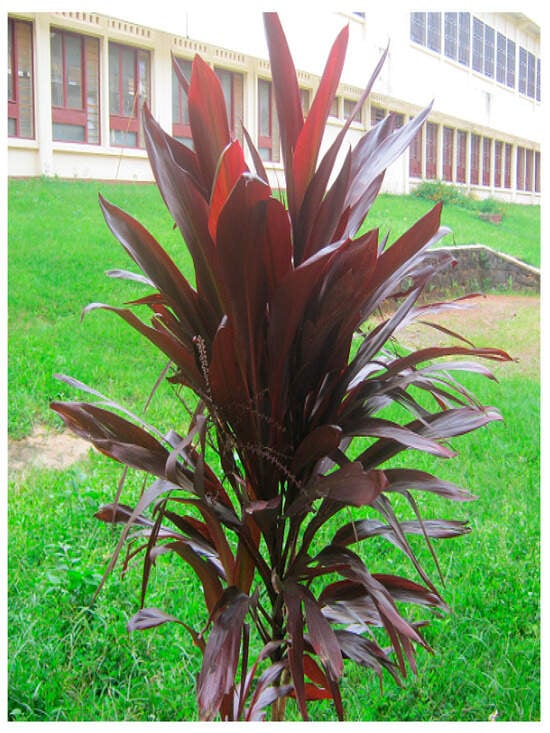You're using an outdated browser. Please upgrade to a modern browser for the best experience.
Please note this is a comparison between Version 1 by Bienvenu Tsakem and Version 2 by Catherine Yang.
Cordyline species have a long history in traditional medicine as a basis of treatment for various ailments such as a bloody cough, dysentery, and a high fever. There are about 26 accepted species names in this genus distributed worldwide, including C. fruticosa, C. autralis, C. stricta, C. cannifolia, and C. dracaenosides.
- Cordyline
- ethnopharmacology
- phytochemistry
- biological activities
1. Introduction
Traditional medicine frequently relies on medicinal plants for the treatment of various ailments and diseases. In developing countries, traditional medicine plays a significant role in delivering primary health care. Scientists have relied on the wealth of the floral kingdom for nearly half of all new drug discoveries to date [1][2][1,2]. Even ornamental plant species can contain a vast wealth of bioactive compounds valuable to medicine [3]. For example, drugs currently in clinical use for cancer treatment include paclitaxel, derived from Taxus brevifolia L., vincristine, derived from Catharanthus roseus (L.) G. Don., and epigallocatechin-3-gallate, a phenolic catechin from Camellia sinensis [4], all of which are better known as ornamental rather than medicinal plants.
Natural products and their derivatives are a significant source for novel drug development in modern medicine, and many of these derivatives form the active ingredient of drugs approved by the U.S. Food and Drug Administration (FDA) [5]. Dependency on direct medicinal plant derivatives is particularly marked in developing countries, where western medicine is often absent or simply too expensive. Plants of the genus Cordyline, well known as ornamental plants, have long been used as a source of traditional medicines and are of great interest in primary health care. As with Taxus brevifolia, Catharanthus roseus, and Camelia sinensis, these plants could be highly significant for drug discovery.
According to the literature, Cordyline species are characterised by the presence of flavonoids and saponins, particularly spirostane, furostanes, and cholestane glycosides, with various structural skeletons [6][7][8][6,7,8]. These compounds have been reported to show a wide range of biological activities, including anti-inflammatory, antiproliferative, antimicrobial, cytotoxic, and hypoglycaemic properties [7][9][10][11][7,9,10,11]. Some activities of these plants have been investigated, prompted by their anecdotal usage in traditional medicine, and various biological activities such as antidiabetic, anti-ulcer, antidiarrheal, wound healing, and anti-inflammatory properties have been reported in several scientific publications [7][12][13][14][7,12,13,14].
2. Botany and Taxonomy
The name Cordyline is derived from the Greek kordyle, which means club, which refers to the plants’ thick underground stems or rhizomes. Royen was the first to report the name Cordyline in 1740 and to propose a classification, but due to the presence of Yucca and Dracaena in his classification, Adanson gave the plant a new generic classification in 1763 [15]. The genus Cordyline, one of the so-called ‘tree lilies’, was placed in the family Laxmanniaceae according to the Angiosperm Phylogeny Group (APG) in 2003, then in the Asparagaceae family in 2009. Also called Agavaceae, this family contains 128 genera, with more than 3000 species [16]. The genus Cordyline contains 26 species alone, of which C. fruticosa, C. australis, C. stricta, C. annifolia, C. rubra, and C. dracaenoside appear to have been the most researched. Cordyline australis, commonly called the cabbage tree and known as ‘ti kouka’ by the Maori people, is the most widespread of this genus and occurs in open places and at forest margins on the three main islands [17]. Cordylines form small trees or shrubs and have leathery leaves, which are often clustered and palm-like in appearance. Cordyline species have creamish white roots that often form root suckers starting from their rhizomes [18][19][20][18,19,20]. Cordyline belongs to the few genera of monocots in which a cambium is present in the stem. The most well-known ornamental and medicinal plant of this genus is Cordyline fruticosa L. (Chev.) (Figure 1), with its beautiful and attractive decorative foliage.
Figure 1.
Cordyline fruticosa
.
